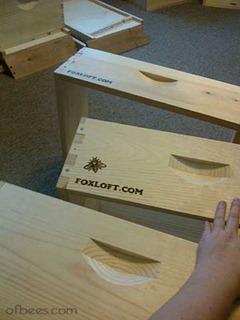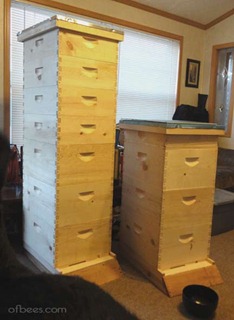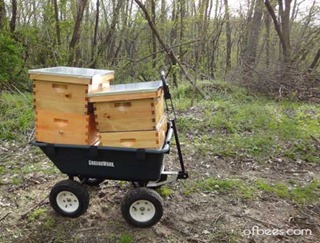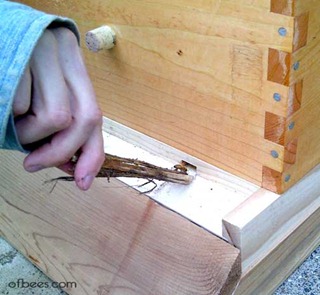We had decided to get bees, we had taken a class about beekeeping, we had read our books, we had the backing of many generous sponsors – so now what? The first step was to get the supplies we needed to house and care for the bees.
We placed our order with a large local beekeeping supply company, Mann Lake, and a few weeks later a truckload of supply boxes was delivered to our front door. We had to assemble the bee boxes (which form the ‘home’ in which the bees build their nest) from pieces, which involved a lot of nailing, gluing, sanding, priming, and painting. We decided to stick with as natural of materials as possible, so chose to finish the boxes with natural stain and wax instead of latex or oil based paints. We stained each of the stacks to be a slightly different color – the reason you usually see bee boxes in such varied colors is that each bee orients itself to its hive when it flies out of the nest – and they use visual clues like color to find their way home. A bunch of solid white hives one next to the other in a row can leave a bunch of very confused bees.
I burned our logo and a little bee glyph on all of our boxes to mark them as our own. Apparently theft of beekeeping materials can be quite a problem in some areas, since the supplies are quite expensive. Here are some of the boxes assembled and ready for finishing. One really amusing effect of doing all of this in our little suburban home (we don’t live out on our farm yet but commute back and forth) is that we have quite nosy and curious neighbors. One day when I was outside on our deck, sealing the boxes, one of our neighbors stopped by to watch and then ventured cautiously, “Are those for bees?” Yes, they are. “Are you planning to keep them… in your house?”. Yes… in our house. Our colonies of thousands of tiny housebees, helping us to pollinate our… dishes? People sure have some funny ideas about bees. No, we are not keeping bees in our house.
Here’s some nightmare fodder for the neighbors – bee boxes in the living room, ready for population! These ‘towers’ consist of 3 deep boxes on the bottom, where the bees build their main nest, honey, and pollen stores for surviving the harsh Minnesota winter with a number of shallow boxes (called supers) on top. Supers, or ‘supes’, are added later, where extra honey stores can be harvested if you’re lucky enough to produce excess. The top is called a telescoping cover, which protects a board that serves as the roof of the hive. The bottom of the hive is a cedar stand which keeps the base off the cold ground and a solid baseboard, which keeps mice and other critters from getting in. A small bar of wood across the bottom opening is called an entrance reducer, which can be turned to make the entrance accessibility smaller or larger throughout the season.
Moving all the boxes out to the farm required a lot of manpower, we don’t have a drivable path yet since spring flooding washed out our ‘driveway’ again.
Once the boxes were installed we put the bees into their new hives and helped a few disoriented stragglers find their way in. You put the bees in the boxes the evening and loosely plug their entrances with grass so that they have to stay inside awhile (hopefully overnight) so they have some time to accept their new home. Otherwise you run the risk of the bees immediately leaving and going off to find their own digs – someplace other than your boxes.

 April 28th, 2012
April 28th, 2012  Foxfeather Ženková
Foxfeather Ženková 



 Posted in
Posted in 
